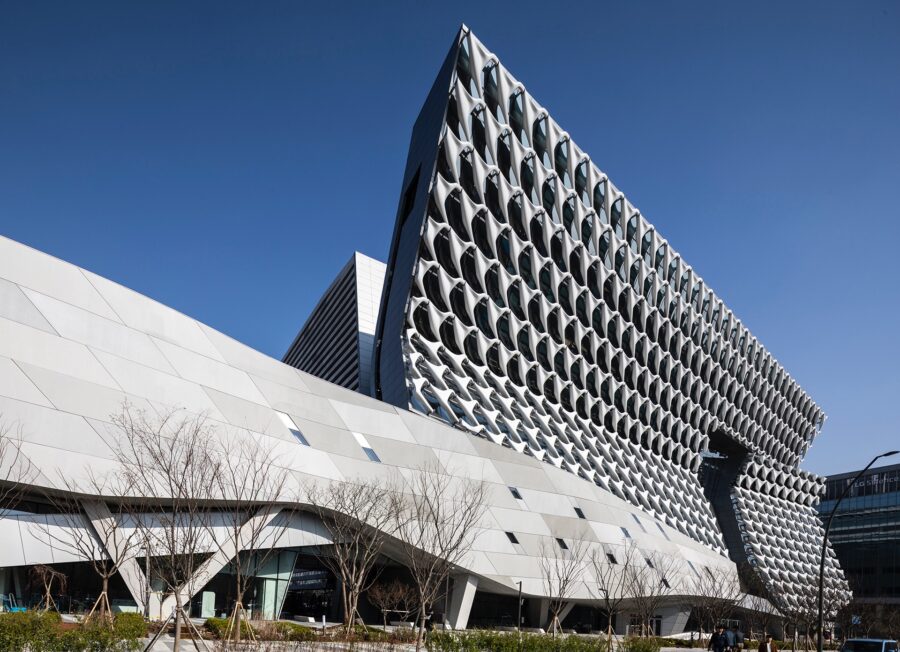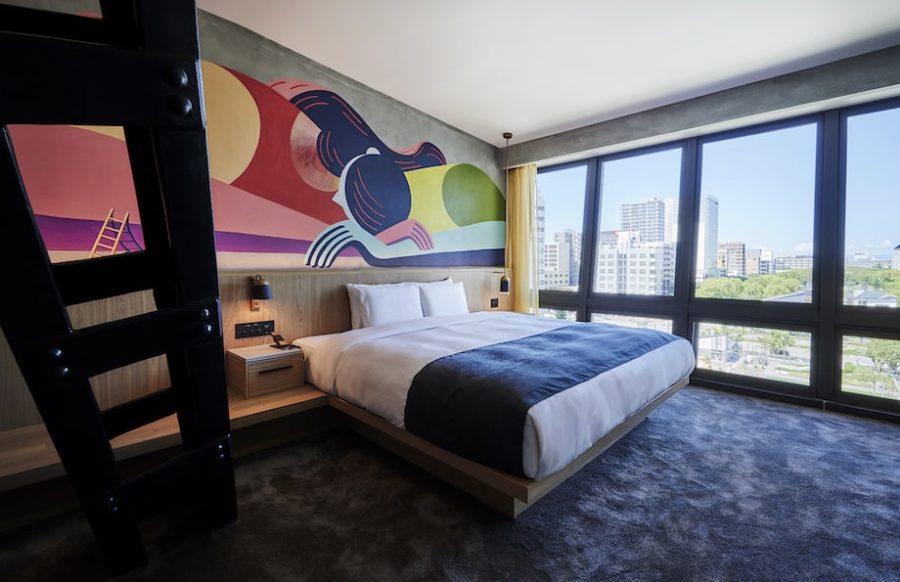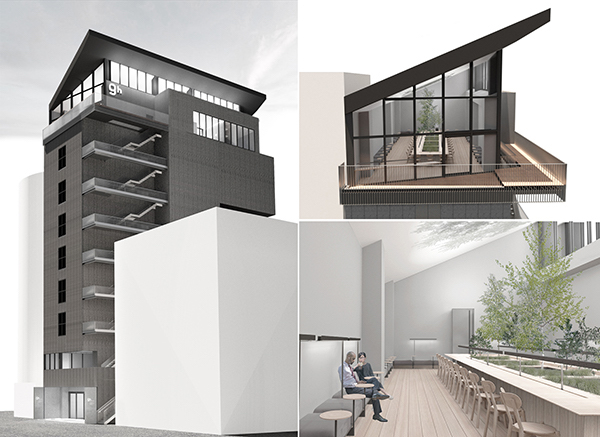
CULTURE


©Kurt Hoerbst
バングラデシュのルドラプールに建つ、障がい者センターとフェア・テキスタイル製作のための小さなスタジオが併設された建築〈アナンダロイ〉。
設計を担当したスタジオ・アンナ・ヘリンガーは、世界各地でさまざまなヴァナキュラー建築を手がけ、「地域経済にも生態学的にも持続可能な環境の創出」をビジョンとしている建築スタジオです。

©Kurt Hoerbst
(以下、Studio Anna Heringerから提供されたプレスキットのテキストの抄訳)
私たちスタジオ・アンナ・ヘリンガーにとって、建築は生活を向上させるためのツールである。ヨーロッパ、アジア、アフリカのどの地域であっても、すべてのプロジェクトは、地元の材料やエネルギー源、労働力に私たちのグローバルな知見を組み合わせて活用している。

©Kurt Hoerbst
地元の「泥」と「竹」でできた建築
〈アナンダロイ〉は、主に地元の農家から仕入れた泥と竹でつくられているため、予算の大部分を現地に還元している。そのため、この建物は単なる建造物ではなく、地域の発展を促す存在となっている。
私たちはルドラプールにおいて過去5回のプロジェクトを経験しているが、ドイツの監理下にあった他のプロジェクトとは異なり、〈アナンダロイ〉はバングラデシュの請負業者であるモントゥ・ラム・ショーと、障がい者を含む村の労働者のチームによって推進された。

©Kurt Hoerbst
隠された存在である障がい者
バングラデシュでは、障がいは前世からの悪いカルマの結果とみなされることが多く、「存在を隠されている」というのが現状である。また、貧困のため家族全員が働かなければならず、障がい者は日中のほとんどを1人で生活している。治療のための場所は国内でも稀であり、ルドラプールのような田舎には存在しない。

©Kurt Hoerbst
当初、この建物はセラピーセンターのみの計画であったが、建物を1階分拡張することにより、村の女性が主導する「ディプディ・テキスタイル(Dipdii Textiles)」のスタジオを受け入れることができた。
この建物のプログラムの一部には、女性が村での仕事を見つけられるよう、スタジオ・アンナ・ヘリンガーが共同で企画、運営をしている。これは、都市への移住に対する有効な対策にもなっている。

©Kurt Hoerbst
誰もが受け入れられ、活躍できる環境づくり
〈アナンダロイ〉のコンセプトは、障がい者に治療を提供するだけでなく、彼らがこの建物で学び、働き、そこでコミュニティと関わる機会を提供し、誰もが必要とされる場をつくることである。

©Kurt Hoerbst
コンセプトを表す象徴的な要素として、1階に設置された大きなスロープがある。このスロープは、この地域で唯一のものであり、工事中もすでに、見学に来た多くの地元の人たちの間で話題となっていた。
なぜ、あのスロープが必要なのか?なぜ、健常者もそうでない人もアクセスできるようにすることが大切なのか?障がいのある人の生活はどうしたらよくなるのか?多様性はどうすれば受け入れられるのか?

©Kurt Hoerbst
「泥」でつくるクリエイティビティ
〈アナンダロイ〉は、泥の可塑性を利用して、より強いアイデンティティを生み出すことを目的としている。
現地では泥は貧弱で古風な素材とみなされ、レンガより劣るものとされている。しかし、私たちスタジオ・アンナ・ヘリンガーにとって、素材の古さは問題ではなく、それを現代的に使用するための創造力の問題なのである。泥の美しさと能力を発揮させるために、単にレンガの廉価版として扱うのではなく、泥の良さを引き出すことが必要なのである。

©Stefano Mori
「コブ(cob)」と呼ばれる特殊な泥の技法を用いることで、型枠を使用せず、直線的な壁と同じように簡単に曲面を施工することが可能となった。
この地域の他の建物は長方形のレイアウトである中、〈アナンダロイ〉はカーブを描きながら、スロープが建築を取り囲んでいる。この建物は「多様性の素晴らしさ」というメッセージを、楽しげな曲面で表現している。

©Stefano Mori

©Stefano Mori

©Stefano Mori

©Stefano Mori

©Stefano Mori

©Benjamin Stähli

Sketches

Master Plan

Plans

Elevation

ディプディ・テキスタイル, ©Günter König
以下、Studio Anna Heringerのリリース(英文)です。
The Anandaloy Building hosts a center for people with disabilities combined with a small studio for the production of fair textiles (Dipdii Textiles).
For Studio Anna Heringer, architecture is a tool to improve lives. The strategy of all of the projects no matter if in European, Asian or African context is the use of local materials + local sources of energy (including manual labor) + global know-how. Because the Anandaloy project is mainly built out of mud and bamboo from local farmers, the biggest part of the budget was invested in local crafts(wo)men. Thus, the building is much more than just a structure, it became a real catalyst for local development.
This project is the accumulation of the learning process of all the five previous projects in Rudrapur, including METI School. Unlike the other projects that were under German supervision, the site was managed by the Bangladeshi contractor, Montu Ram Shaw and the team of the mud and bamboo workers from the village, including some persons with disabilities. As for Studio Anna Heringer know-how transfer is key, this project is a great proof that the knowledge is now really rooted.
Often viewed as an outcome of bad Karma from past life, disabilities in Bangladesh are rather hidden, than included. Besides this poverty forces every grown-up member in the family to work and mostly people with disabilities are left on their own during the day. Places for therapy are rare in the country and not existing at all in that rural area of Rudrapur.
In the beginning the building was planned as a therapy center only, but we were able to extend the building into another story, hosting Dipdii Textiles, a studio for the female tailors in the village. This part of the building’s programme is co-initiated and taking care by Studio Anna Heringer in order to allow women to find work in their villages. It is an effective counteract to the urban-rural migration. The concept was also not only to provide therapeutic treatment for the people with disabilities, but also provide them an opportunity to learn and work in that building and engage in the community there. Everybody wants to be needed.
As a visible sign of this inclusion a big ramp winds up the first floor. It is the only ramp in that larger area. Already during the construction, it has been topic of discussions amongst the many local visitors that are coming to see the site. What is the reason for that ramp? Why is it important to guarantee access to everyone, no matter if healthy or not? How can the lives of people with disabilities be improved? How can inclusion be incorporated?
The building`s architecture explores the plastic abilities of mud in order to create a stronger identity. Mud is regarded as poor and old-fashioned material and inferior to brick for example. But to us, Studio Anna Heringer, it doesn’t matter how old the material is, it is a matter of our creative ability to use it in a contemporary way. To show the beauty and capacity of mud, it is needed to bring out the best of it and not just to treat it as a cheaper version to brick. With that particular mud technique, called cob, no formwork is needed and curves are just as easy to be done than straight walls. Unlike the other buildings in that area that are erected in a rectangular layout, the Anandaloy Building breaks out of the mold. It dances in curves, the ramp winds playfully around its inner structure. On a symbolic level the building signals: it is great that we human beings are all different. With its joyful curves it radiates the message: diversity is wonderful!
FACT BOX
- Start of planning: September 2017
- Construction: September 2018 – January 2020
- Client: Dipshikha Bangladesh
- Site: Rudrapur, Dinajpur district, Bangladesh
- Sponsor: Kadoorie Foundation, Lutz & Hedda Franz Charitable Trust
- Concept and design: Anna Heringer
- Project management/drawings: Stefano Mori
- Consulting: Martin Rauch (earth and bamboo details), Andreas Guetling (roof construction), Emmanuel Heringer (bamboo roof)
- Contractor: Montu Ram Shaw
- Building footprint: 253 m²
- Floor area: 174 m² (rooms), 180 m² (ramp and veranda)
- Materials/techniques: fired brick foundation, mud walls (cob technique), bamboo pillars/ceilings and roof structure, straw roof (lower roof), metal sheet roof (upper roof)
「Anandaloy: Centre for People with disabilities + Dipdii Textiles studio」Studio Anna Heringer 公式サイト
https://www.anna-heringer.com/projects/anandaloy/









